

A note about sources: The major primary sources for this project may be found in the University of Waterloo Special Collections and especially in the Wes Graham Papers which constitute an extensive series of files related to the development of computing and to the creation of several "spin off" companies, including WATCOM (now Sybase), Waterloo Maple (now Maplesoft) and the Oxford Dictionary project out of which was created Open Text. Illustrations used for this website are drawn from the Special Collections' files as well as the University Archives. Others are from private collections as well as from a large collection of photographs from the Computer Systems Group and identified herein as the Don Cowan Collection. Those identified as Private Collection are held by the author; those with index numbers 75-0000-0 are in the UW Special Collections series. Others of an historical nature are from the Kitchener-Waterloo Record Photo Negative Collection in the Special Collections Department in the Dana Porter Library.
The first computer was installed for use in industry in Canada in 1955.
The Waterloo College Associate Faculties, which in 1959 became the University of Waterloo, received its first students in July, 1957. In October of that year, the first group of Co-op engineering students embarked upon their initial work terms. The alternating work-study program at Waterloo profoundly influenced the character of the University of Waterloo as well as its computing programs which early on acquired a practical application in the creation of software.
The successful launch by the Soviet Union of its Sputnik I on October 4, 1957 caused a dramatic shift in emphasis toward science and engineering. In the inevitable space and technological race that followed, the development of computing and computer applications would take a prominent place and within this field the new University of Waterloo would establish an extraordinary reputation. International political developments, the expanding Canadian economy, the rise of computing, the need for more trained industry professionals, and the introduction of Co-op education helped to ensure that UW would begin its existence as a school with a strong technical and scientific focus, while its Arts and Science faculties grew quickly in order to meet the need for teachers in Ontario's rapidly growing school system.
IBM invented the first disk with memory, and the first FORTRAN compiler was developed for the IBM 704. These events were crucial to computing at Waterloo as Waterloo's creation of the unique WATFOR compilers brought an international reputation to the fledgling institution.
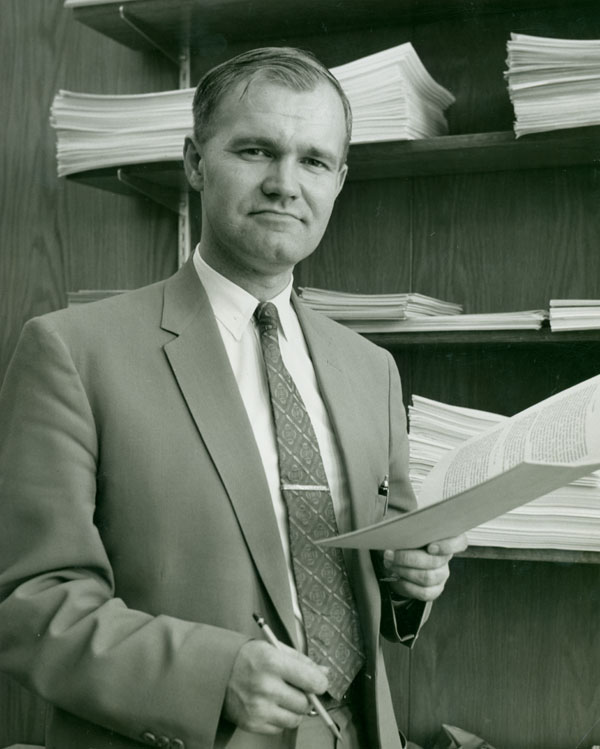

Stanton joined the faculty of Waterloo College as Head of its Mathematics Department. Stanton was intrigued by the idea of starting a new university and he had a profound effect on Waterloo's growth, including the creation of its Faculty of Mathematics in 1967.

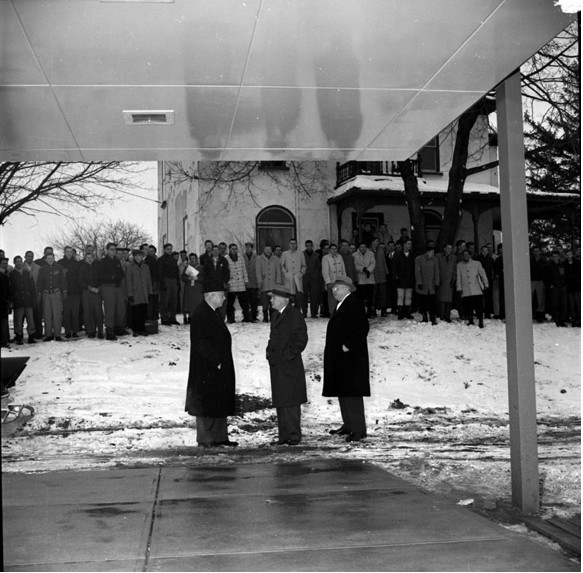
The University of Waterloo began as the Waterloo College Associate Faculties in 1957. By 1958 construction had begun on the land adjacent to the Schweitzer Farmhouse (shown above). The farmhouse was used briefly for faculty offices, including Stanton's; today it serves as UW's Grad House. This photo, which still captures the ambience of a 19th century Ontario farm house, is of a more recent time; visible in the background is the Dana Porter Library. (
J. Wesley Graham arrived at Waterloo College as a lecturer in the mathematics department. Previously he had been the head of the Applied Science Division at IBM, a department that had more than 100 employees. As a former student of Ralph Stanton's at the University of Toronto, he was recruited to Waterloo by Stanton. At the time, Graham hoped to lessen his involvement in computing and devote himself to teaching. As it turned out, Graham's determination to take computing to undergraduate students became a hallmark of the Waterloo experience and led to the creation of software that overnight made Waterloo internationally recognized, while Graham's contacts in the area of computing enhanced the new university's reputation and its acceptance in this rapidly developing field.


The Physics and Mathematics building, the second on the new university campus, greeted new faculty members and students in September 1959, but it was not officially opened until February 10th, 1960. Waterloo's first computer was installed in this building.
Ralph Stanton established a program of Graduate Studies in Mathematics with the beginning of the university. The first degree awarded in 1960 was to Ronald Mullin, an MA in the Faculty of Arts in Mathematics.




Under Stanton's direction, UW also saw the first use of a computer in 1960. Stanton brought in a Bendix G-15, an early model digital computer, on a trial basis in early to mid-January. He tested the machine's ability to do advanced mathematics by making the Bendix salesman program the machine to solve complicated formulas. Stanton would then solve the same problem by hand and compared his own result to that of the machine. Shortly thereafter Stanton urged that a committee be struck to find a suitable computer for UW's needs. Basil Myers, Chairman of Electrical Engineering, became the head of the university computer committee.
In February, Myers recommended the lease of an IBM 1620 to President Hagey
Since final delivery of the IBM 1620 could not occur for roughly one year, Wes Graham, who was familiar with IBM product lines and inventory, recommended the temporary use of an IBM 610 digital computer which could be shipped immediately.
On July 1, 1960, the IBM 610 was installed, and J.D. Lawson a lecturer in the Department of Mathematics was appointed Supervisor of the Computing Centre.

On July 25, 1960, the University Computer Committee appointed Basil Myers as Director of the University Computing Centre and Ralph Stanton as the Supervisor of the Computing Centre.
On November 3, 1960, Dr. H.K. Kesavan was appointed joint Supervisor of the Digital Computing Centre to assist Mr. J.D. Lawson, a UW lecturer in 1960. At that time, the Computer Committee submitted a tentative budget that estimated the University's expenditures on computer facilities would be $50,000. More than 4/5 of the budget went to analog computing facilities.
As members of the University Computer Committee, Myers and Lawson recommended the purchase of the machine to President Hagey, largely on the advice of Wes Graham who In 1960 and 1961sat on the university's computer committee where his knowledge of IBM products and procedures proved very valuable.

In 1960, UW began teaching computer science courses to students in mathematics, science, and engineering at the undergraduate level. Several courses were also being taught at the graduate level.


Don Cowan, a graduate of Engineering Physics at the University of Toronto, a program in which Ralph Stanton taught before coming to Waterloo, arrived at UW on September 15, 1960 to serve as an instructor and to begin graduate studies. Cowan completed his Ph.D. at Waterloo and served as the first Chair of the Department of Computer Science
Ralph Stanton's textbook, Numerical Methods for Science and Engineering (Prentice Hall, 1961) was the first undergraduate textbook used at UW to include a chapter on computing. Not only did this text book make computer applications relevant in other fields but it began to identify Waterloo as an institution where applied numerical analysis was seen as an important part of the academic tradition.

On February 6, 1961, the University Computer Committee decided to tentatively charge a fee $20 per hour of computer time when the machine was being used for supported academic research.
On the same day, the committee also recommended that the university order auxiliary input equipment for use with the IBM 1620 digital computer. The order consisted of four type 026 Printing Key Punches and one type 063 Tape Punch. The total monthly charge for the equipment including punch cards was $180.75.
On March 3, 1961, the Committee made arrangements for the university to join the 1620 Users Group.
On April 17, 1961, the IBM 1620 arrived on campus. It was rented from IBM with substantial educational discounts and came with a price tag of $672.00 per month.

In September 1961, the IBM 610 computer was returned to IBM.
On December 1, 1961, the committee estimated the cost of the IBM 1620 computer and its peripherals to be $922.00 per month. They claimed that their budget, of $11,070, exactly covered the amount excluding sales tax.

Wes Graham was appointed the first Director of the new Computing Centre, which had become a separate department at the university. Previously the Computing Centre had been a division of the Electrical Engineering department, with Basil Myers as Director and Ralph Stanton as Associate Director. The added responsibilities entitled Graham to an additional stipend of fifty dollars per month.

In the spring of 1963, UW purchased the IBM 1620 outright. By 1966, the 1620 was dedicated entirely to student computing. It was available for use by students from 9:00 to 11:00 p.m. and when equipped with a powerful compiler it could process roughly two thousand student jobs.




Ralph Stanton urged the creation of a Computer Science Division within the Department of Mathematics.
In the fall of 1964, Co-op was introduced into the mathematics curriculum. Forty students were expected, 100 enrolled. The program included options in computer science. The next year the popularity of the course increased by 100 per cent as 200 students enrolled in the program. At the time, Co-operative Mathematics with Computer Science Options, the official name of the Co-op course, was the only academic program of its type in the world.
While visiting the University of Wisconsin with Stanton and Graham, Gus German, an undergraduate enrolled in Mathematics, acquired a copy of the FORGO interpreter. Once the program was installed at UW, it allowed programs that previously ran for one hour to be processed in one minute. At top speed the interpreter allowed 200 jobs to be processed in a single hour.
The first Computer Science Days were held in November of 1964. Don Cowan conducted the initial sessions.
In October, 1964, the IBM 7040 and 1401 arrived at UW. The integrated system gave the university one of the most sophisticated hardware packages in North America, although other universities had the same system. The computers and their integrated components cost roughly two million dollars (Ponzo 27).
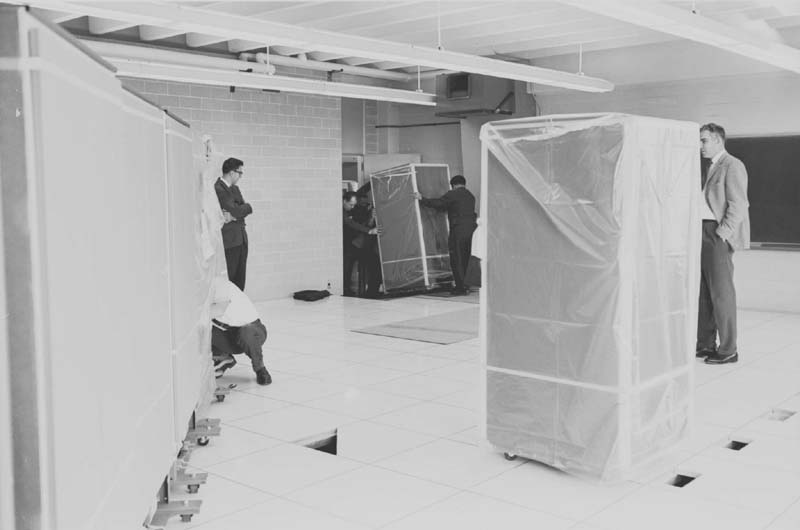
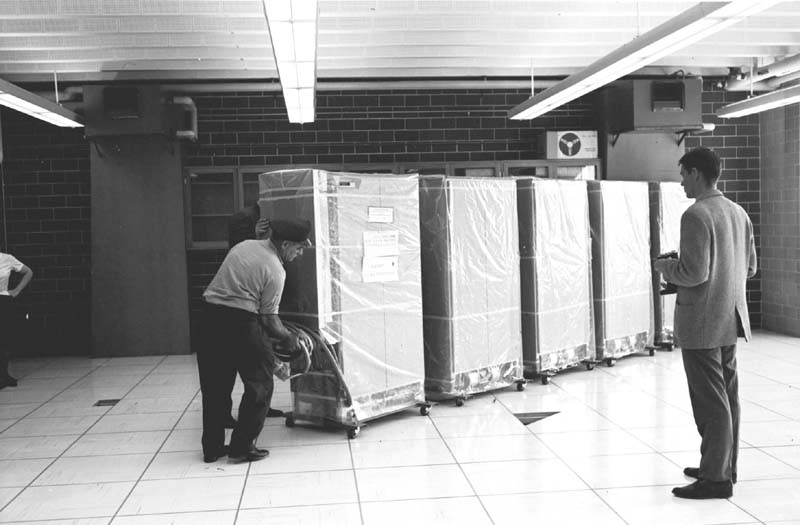
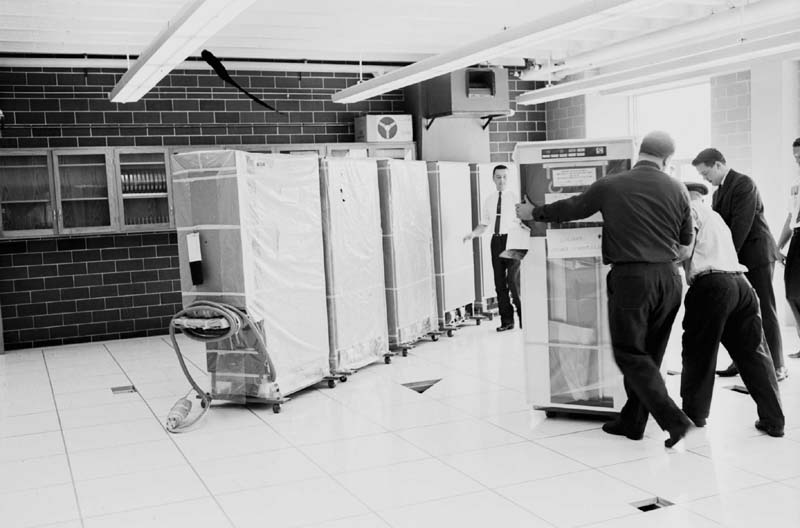
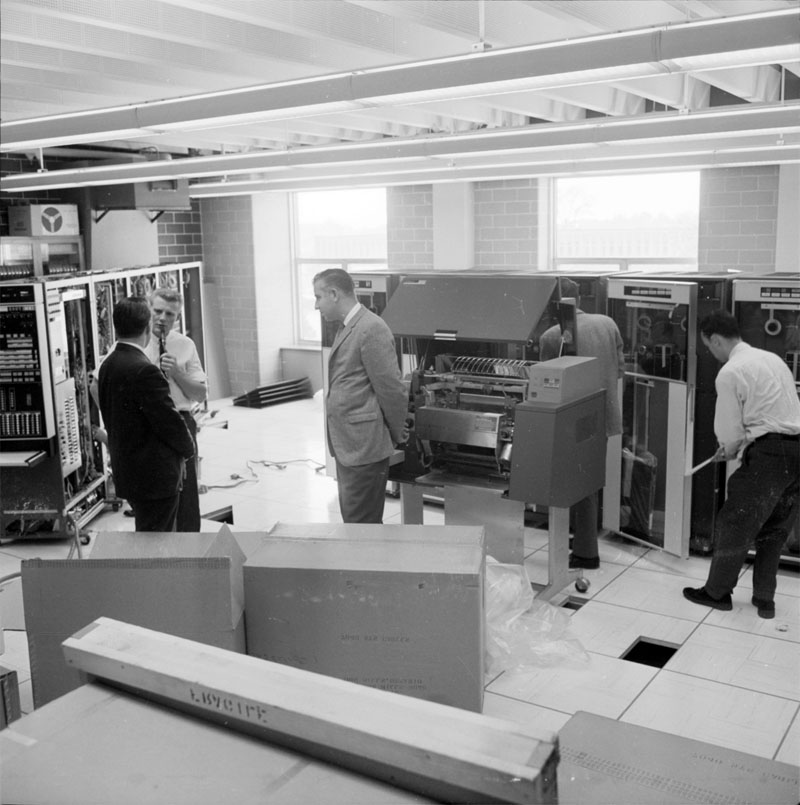



In November, 1964, an IBM 1710 (a modified 1620) Control System was added to the array of computer equipment at UW. It had a number of peripherals that made input/output faster and easier.
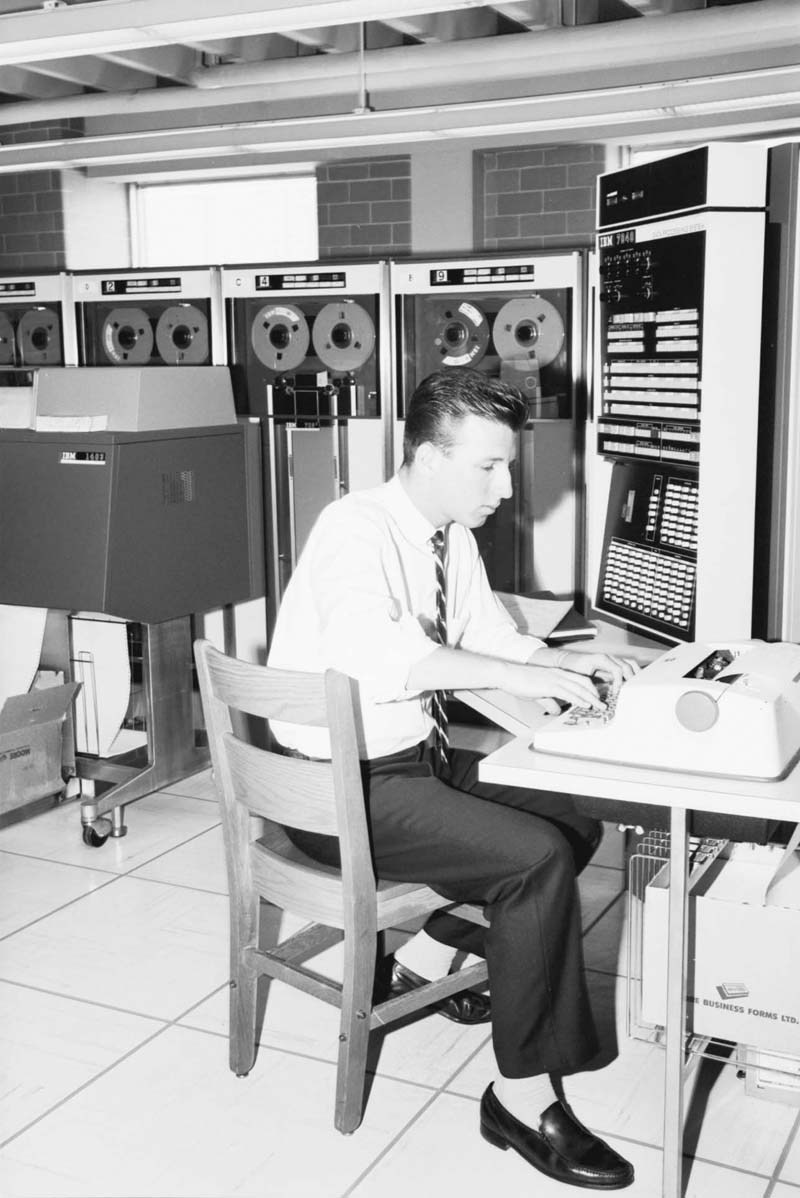
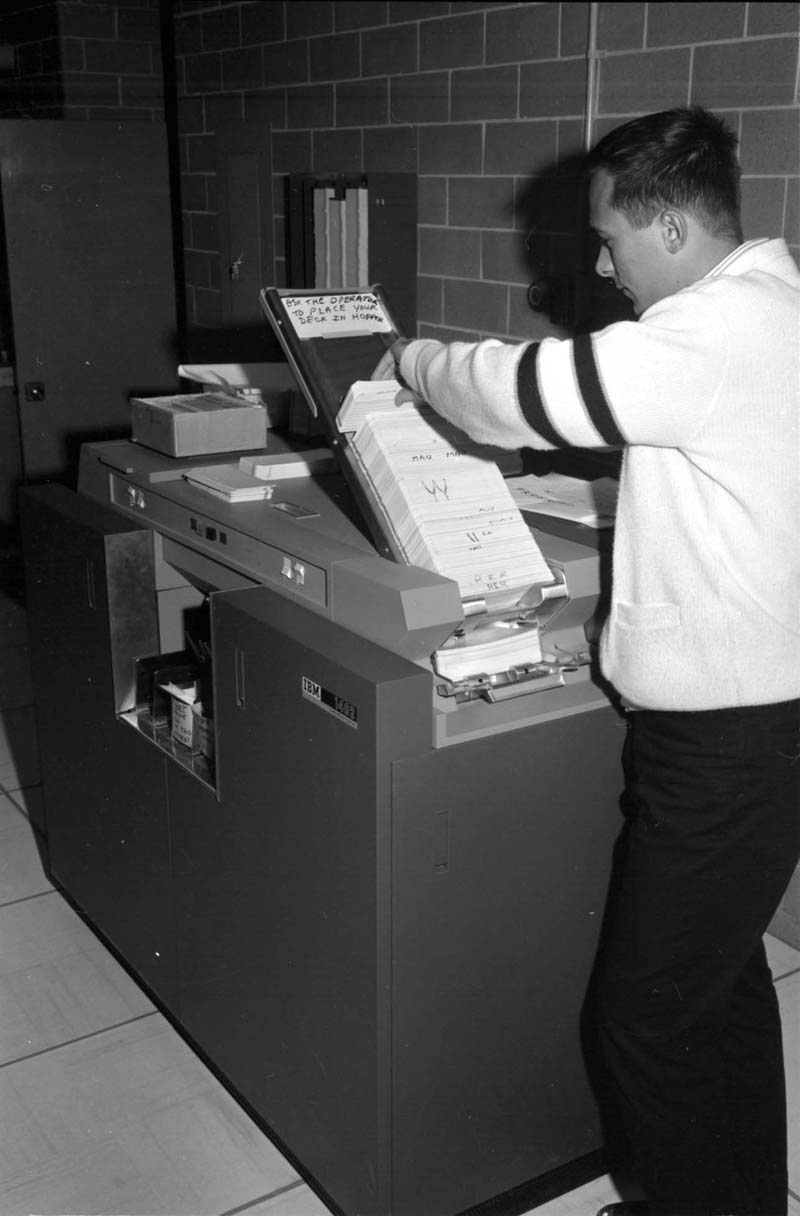
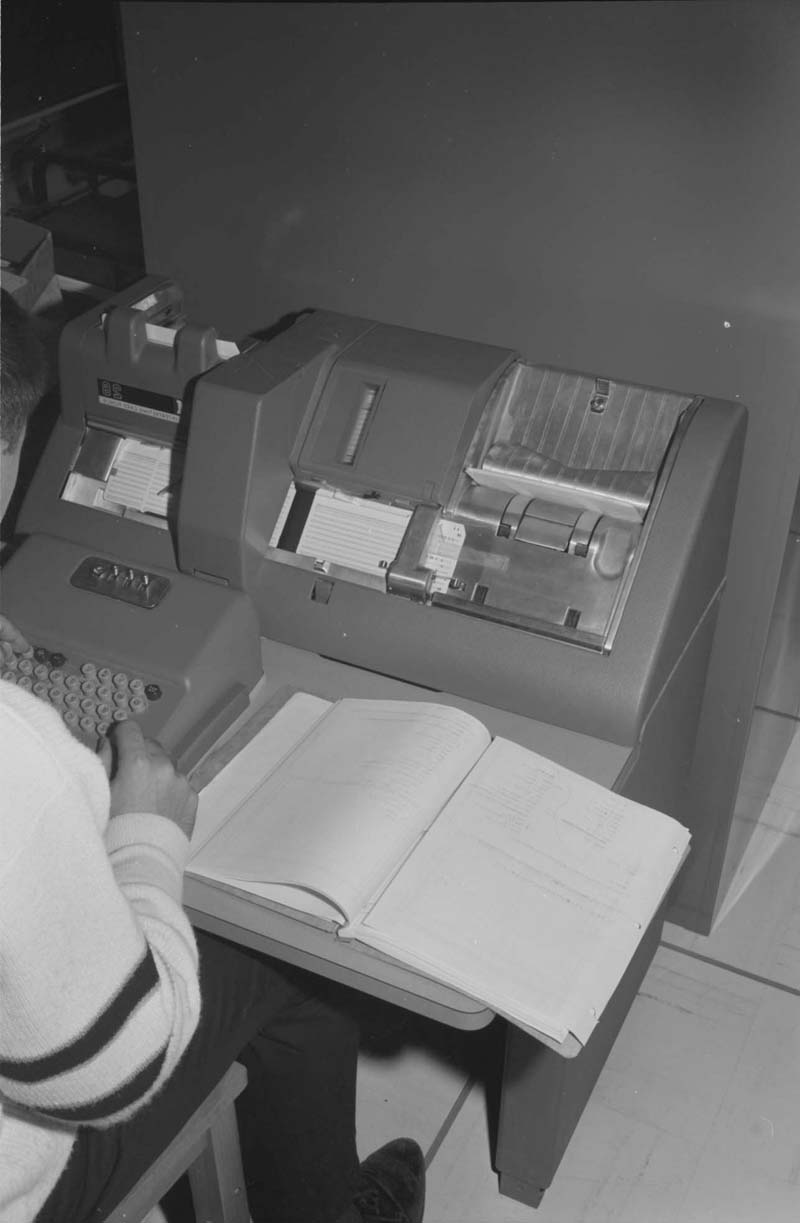
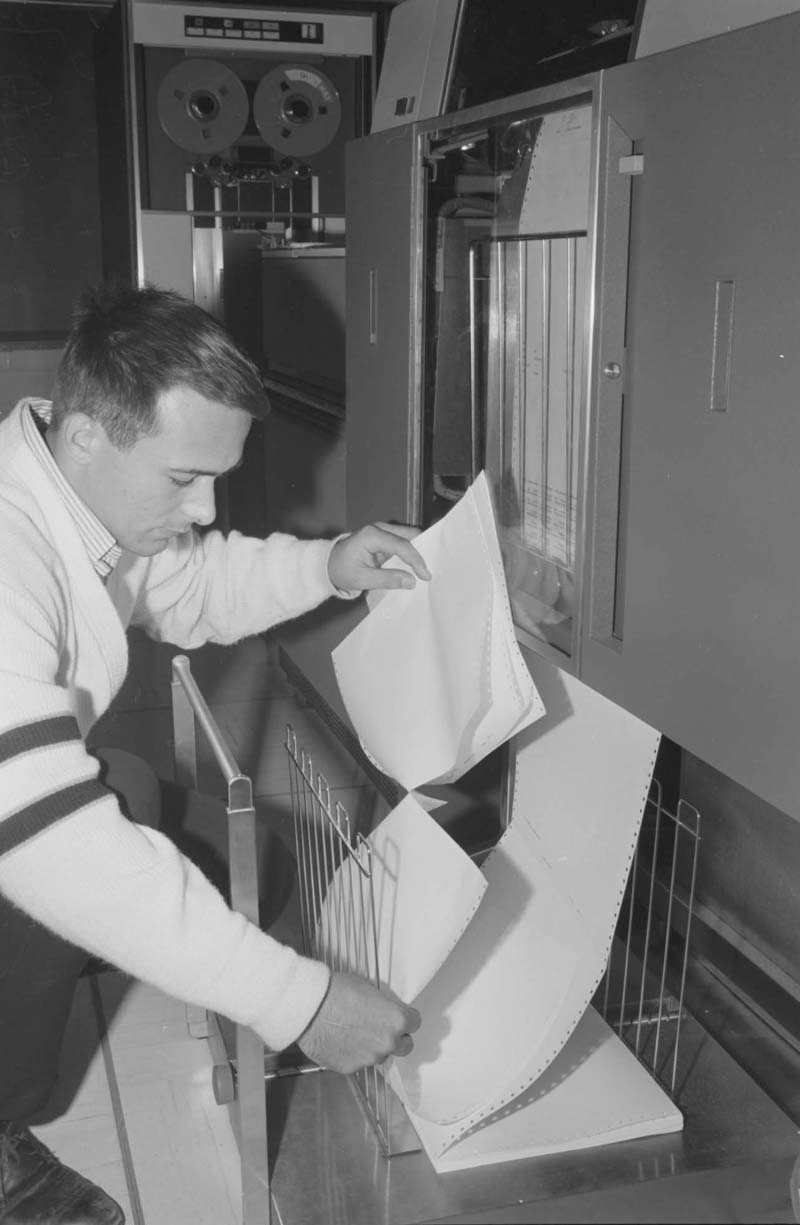
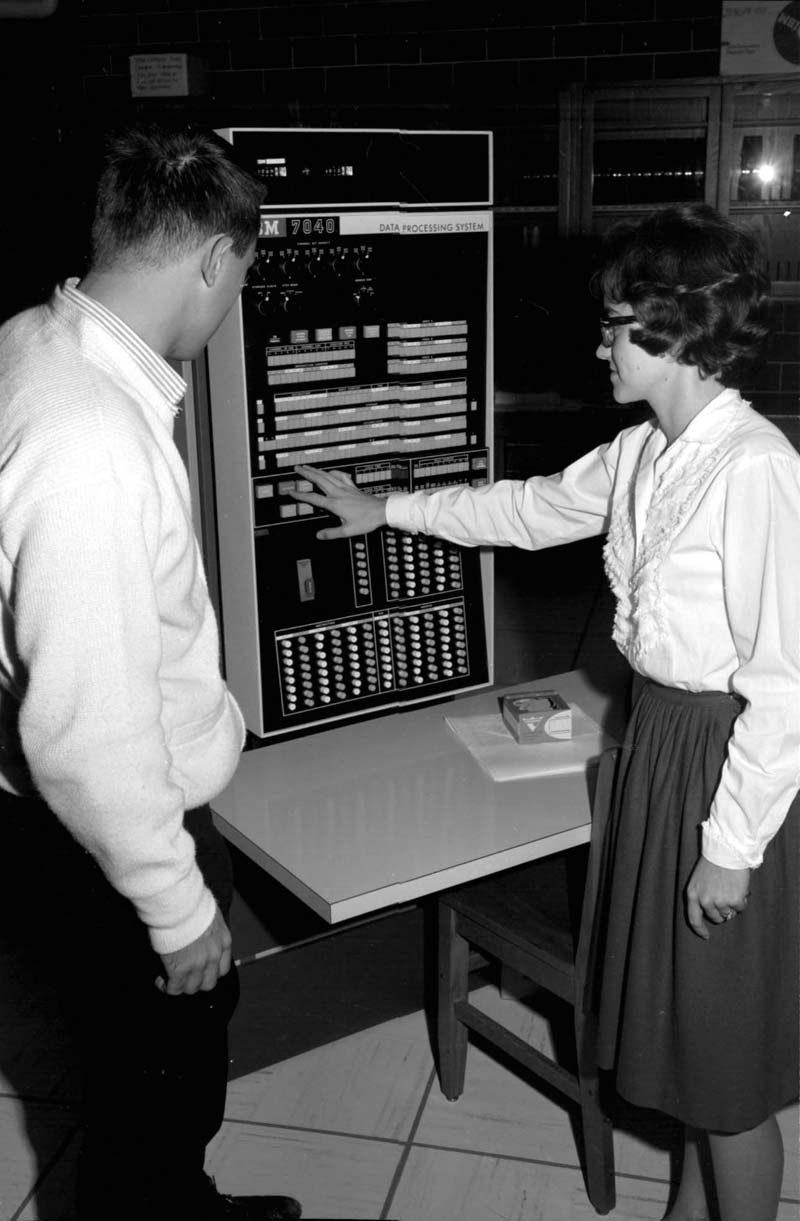
SPECTRE, a hypothetical computer, was completed in 1964. It allowed the Computer Science Department (CSD) to teach assembly language and machine architecture to mathematics students (Ponzo 48). SPECTRE's interpreter was written in FORTRAN, and SPECTRE MAP was the assembler for the program (Cowan, Graham, Mackie 27).

In June of 1965, Gus German, Robert Zarnke, and Hugh Williams solved the Archimedes Cattle Problem. No complete solution to the problem had ever been devised by mathematicians in over 2000 years. The problem was first proposed by the Greek mathematician Archimedes of Alexandria in 200 BC. The UW team used a combination of the IBM 7040 and 1620 computers to produce the solution which had over 200,000 digits. When they successfully solved the problem, Wes Graham contacted major newspapers to ensure that the team, who had laboured in their spare time, received full credit for their work (Ponzo 29).
Later in the summer, another team that also included Gus German and Bob Zarnke, of the Archimedes Cattle Problem team, as well as Richard Shirley and Jim Mitchell wrote the first WATFOR compiler program. The compiler was an immediate success and by the fall it had over 2,500 users at UW. What was more remarkable was that at Waterloo this compiler had been created by four undergraduate students working over one summer.
By November 1965, five Canadian schools, eleven American installations and one in Switzerland had requested a copy of WATFOR. By June of 1966, requests were received from an additional two Canadian locations, thirty-six American, and six international installations The WATFOR compiler was acknowledged to have increased the computing capacity at the university by 5 times, thereby saving the university dollars in hardware and software upgrades that most certainly would have been required to provide necessary computing service.
The original WATFOR compiler for the FORTRAN IV computer language for the IBM 7040 computer had diagnostic capabilities superior to most of its contemporary counterparts so that users could find and correct errors. The program greatly expanded the potential for using computers in undergraduate instruction and it put the fledgling university on the map internationally.



By the mid-1970s, 10,000 Ontario High School students were visiting UW annually for Computer Science Days. The events became so significant that special software was created to help the students write successful programs. (Please see below). Grade One students visited UW for the first time and toured the computer installation. After the tour the students constructed a cardboard facsimile under the guidance of their teacher. (Ponzo 49). Computer Science at Waterloo had captured attention beyond the normal areas that one would associate with so new a university. Years later students and faculty members would explain their decisions to attend the University of Waterloo because of their experience at Computer Science Days.
Paul Cress wrote TUTOR, a simplified version of BASIC/FORTRAN, to be used on Computer Science Days.
By 1966, computing was a $2.5 billion industry growing at a rate of 25% per year, which had 185,000 college graduates working in the field. At that point, the number of professionals working in the industry was expected to grow by 20% per year.
In 1965, Don Cowan obtained his PhD in Mathematics. In the summer of 1966, he was appointed the first Chairman of Waterloo's Computer Science Department. The name of the department was changed to Applied Analysis/Computer Science (AA/CS). When Cowan accepted a research group of experts in applied analysis into the enlarged department. Cowan shaped the department in an area that was still little known in the university community. By 1972 the department had 35 members.

In the 1966 academic year, Jerry Bolce wrote a Waterloo version of LISP, a language that was important to artificial intelligence. Bolce's version was known as LISP 1.5 (Ponzo 34). The Z1 programming language was also written at UW in 1966 by Bob Zarnke (pictured below), this language helped in the development of compilers and other systems software. It is likely that Z1 was one of the first for developing programming systems. (Cowan, Graham, Mackie 27).

In the fall of 1966, a number of High School teachers began teaching experimental classes in computer science. Many of the teachers involved in the program had attended a computer programming course at the UW during the previous summer.
The Computer Centre lent support to the program by making its computer facilities available to interested schools. As of October 1966, nineteen schools had registered to use UW's IBM 7040 computer. At that time, the principal computer program used for the project was SPECTRE.
Mathematics became a separate faculty on 1 January 1967, with David Sprott as the first Dean of Mathematics. The UW Faculty of Mathematics was the first of its kind in North America and perhaps throughout the world.

UW acquired the IBM 360/75 to supplement the 7040 and 1401. The 360 was twenty times faster than the 7040 and 1401 computers.
Even before the arrival of the 360/75, Paul Dirksen and Paul Cress had begun writing the WATFOR 360 compiler. (Later versions became the WATFIV (Waterloo Fortran IV) compiler for this machine.)
This was Waterloo's most successful compiler. It was first known as WATFOR and later as WATFIV when FORTRAN language extensions presented at a SHARE conference were added to the program. The acronym WATFIV literally stands for "Waterloo (WAT) FORTRAN (F) 4 (IV)."
WATFOR 360 was developed in 1967 and it greatly enhanced the speed and ease of use of the IBM 360 series of computers. The program was essentially WATFOR for the IBM 360 series, the latest in computing technology at the time. It was also the early student-friendly variant of FORTRAN IV. The group leaders of the team that created the compiler, Paul Dirksen and Paul Cress, won the Grace Murray Hopper Award in 1972 for their efforts. In 1973, WATFIV was augmented with structured programming constructs and character variables to create WATFIV/S (Cowan, Graham, Mackie 28).


Despite the widespread demand for the services it provided, the Computing Centre had its budget cut, a sign of difficult times and the need to create an awareness of the importance of computing for UW at a time when UW had nine construction projects underway, including the new Mathematics and Computer building.



At the ceremony in 1967 when the Mathematics and Computer building was unofficially opened, the new building was decorated with an enlarged replica of one of Ralph Stanton's favourite ties. This tradition of hanging a pink tie on the building has been an enduring legacy.

The building was officially opened in May, 1968.



In 1967, the Computing Centre had moved its formidable array of equipment into the Mathematics and Computer building. The department had four computers to relocate and some of them were quite massive: the IBM 1620, 1710 and 360/75. It was not until1968, however, that the faculty members of the department were able to take up their offices in the new building.









In 1967, the Combinatorics and Optimization Department of the Mathematics Faculty was approved by the Board of Governors. Along with the nascent department of Computer Science, this new department would shape the international reputation of the university.
For the 1967-68 academic year Mathematics had an enrolment of 1,430. Of those students, 130 were doing graduate work and 600 were in Co-op. The rest of the students were regular undergraduates There were now more than 150 companies involved with Co-op.
Professor John Brzozowski, formerly of the University of Ottawa, joined UW. Brzozowski's arrival signalled the development of the theoretical orientation in C.S., which would be an important complement to the existing renown in computing applications for which Waterloo had become known worldwide.
Wes Graham travelled through South America in 1966 at the request, and expense of IBM. The trip allowed Graham the opportunity to discuss UW's programs with other university leaders. At this time, Graham established "the Brazil connection" with professors from the Catholic University of Rio de Janeiro Brazil, a relationship that continues to the present.
In response to the rapid growth of computing among students at Waterloo, the TRACE program was developed in 1967 by Rod Milne to provide better debugging facilities for machine and assembly language programs (Cowan, Graham, Mackie 28).
The November 1, 1967 issue of the Computing Centre Newsletter announced that the centre would provide automated marking of multiple choice tests and exams for professors. The forms that allowed for this process were quite limited in that tests could only be 52 or 80 questions long. Only student numbers, but no student names, could appear on the test paper.
In 1968, Curricula '68 was introduced by the Association of Computing Machinery (ACM) to formalize Computer Science as an academic discipline standardized across North America. This new curriculum established a set of courses that emphasized the theoretical and mathematical foundation of Computer Science. As the program started to be broadly implemented, Computer Science courses and degrees became available at universities across North America. With its recent appointments in Computer Science, the University of Waterloo was well placed to maintain a prominent position in this new curriculum.
In this same year, the Physics Department made the purchase of a tape duplicating machine so that audio tapes could be sent to students instead of the students coming to classes in the evenings and weekends, thus beginning UW's correspondence or distance education program which grew to be one of Canada's foremost programs of this type, evolving along with new technologies to introduce CD ROM video delivery systems in order to bring the best of UW's courses to students unable to come to campus and in recent years to offer an alternative to some oversubscribed campus courses . In 1968, in response to budget restrictions, Computing Centre Director Wes Graham reduced the daily hours of the computing centre from twenty-four to eight hours. In an innovative move to raise funds, computer time was rented to private businesses that were waiting for the arrival of newly ordered computing equipment. The University's credibility rose dramatically with local companies, but UW had to ration its own time using the computer. Competing demands for computing time foreshadowed the voracious appetite that would develop around computing use on and off campus. The plan to pay for the computer and to give all faculties the time that they required on the machine would consume much of Graham's efforts in the coming years. At the same time, the use of the UW computer by local industries and companies created new bonds between the university and the community.
The ASMG assembler was developed as a high-speed assembler for the IBM 360 and 370 computer systems by Rennie Peterson. It was based on ASMF, but greatly out performed that compiler (Cowan, Graham, Mackie 28).Also created in 1968, PDSQUISH was a program first used on the 360 and 370 computer systems that compressed partitioned data sets without copying them, and hence allowed more effective use of disk storage (Cowan, Graham, Mackie 28). IBM's IEMCOPY fulfilled the same function but ran too slowly for UW's needs, so the PDQUISH program was written by Mike Doyle, placing UW in the vanguard of this form of software development.
In 1969 Applied Analysis/Computer Science became the largest department within the Faculty of Mathematics.
UW hosted the Tenth Annual Symposium on Switching under the direction of Dr. John Brzozowski. This conference represented the first time that the event was held outside the United States. Many of the leaders in the field of theoretical computer science came to Waterloo for the first time. (Ponzo 56).
In 1969, the Computer Systems Group (CSG) was set up to facilitate the writing, maintenance, documentation, and distribution of software. CSG was conceived as a not-for-profit organization that would license UW software products to other universities and installations. CSG was founded largely on the strength of software products like the WATFOR and WATFIV compilers. According to Wes Graham's records, the CSG had been operating on an informal basis for three years prior to March 25, 1969.
The Mathematics Faculty switched to a credit system and abandoned the old system of progress by year, enabling the system of Co-operative education to expand within the Faculty. It would take another decade before all of the university faculties would make this move, but Mathematics was clearly in the vanguard. The fact that Mathematics had taught term courses in Engineering made this a fairly simple transition.
On Monday, November 9th, 1970, UW opened a debug terminal in Engineering 1308 in order to help students remove the glitches in their programs and to avoid them having to walk to the Mathematics and Computer Building. The picture below shows a technician at the debug counter being approached by students seeking assistance. The picture was first featured in the Computing Centre Newsletter.

C.R. "Bob" Zarnke, who formerly helped solve the Archimedes Cattle Problem and was one of the students who wrote the first WATFOR compiler, completed his PhD thesis, entitled "A Software Development Language." This is regarded as UW's first PhD thesis on software. Zarnke's thesis supervisor was Don Cowan.
In September of 1972, the Honeywell 6050 was installed in the Mathematics and Computer Building. Later in the year, a software tools package was developed for the computer by UW. The tools package became standard on all 6050-like machines (Ponzo 52).
The first IBM 370 computer arrived in 1972, its initial purpose was to run many of the student jobs being run at UW and thus relieve some of the strain being placed on the 360/75. The 370 was a model 145.
David Sprott retired after a successful tenure as the first Dean of Mathematics to be succeeded by William Forbes as Dean of the Faculty of Mathematics.
In 1969 and 1970, the WATBOL compiler was completed. The WATBOL compiler for the COBOL programming language had speed and error diagnostics similar to the WATFOR compilers for FORTRAN. The need for a usable COBOL-based complier was created by the Co-op program. In order to be successful in their work placements, UW students needed to understand business data processing systems and how to program using COBOL, but most COBOL compilers did not have the speed or error diagnostics to meet the needs of students and educators, so UW wrote their own compiler to satisfy the unique requirements of students, faculty, and Co-op employers.
Two years later, in 1972, Rod Milne and Ron Hurdal of UW's Computer Centre, wrote a final version of the WATBOL compiler. It allowed AA/CS to teach data processing, a necessary skill for students enrolled in the Co-op program. At this time, there were no other compilers available to support the educational use of COBOL. The compiler provided fast compilation, and excellent comprehensive error diagnostics. It also ran on the 360 and 370 family of computers and was known as WATBOL.
Distribution of the WATBOL was handled by CSG (Cowan, Graham, Mackie 28). Even in the early 1990s, hundreds of institutions were still using the program (Ponzo 89).
Web reference: http://csg.uwaterloo.ca/sdtp/watbol.html
The Computer Communications Network Group was established in 1972. The project was a joint venture between the Electrical Engineering Department and AA/CS. Eric Manning was the project director. Nominated by Wes Graham for their innovative work at UW, Paul Dirksen and Paul Cress received the Grace Murray Hopper Award for the development of the WATFOR 360 compiler. The Grace Murray Hopper Award is given to recognize important contributions to computing made by individuals under the age of thirty-five. Grace Murray Hopper was the creator of COBOL.

In 1973 Wes Graham stepped down as the Director of the Computing Centre and the Deputy Director, Paul Dirksen, was appointed Director, ending the colloquial use of the title, "Deputy Dirk."
The Computer Systems Group (CSG) was officially established by the UW Board of Governors on 6 February 1973. In that year, the group was given a constitution and by-laws. Its mandate allowed it to act as an independent software distribution business within the university; all profits from software sales and other sources were re-invested in computer research at UW. Ultimately this initiative would lead to the creation of the University of Waterloo's spin off company known as WATCOM.

The CSG developed WATIAC, a hypothetical computer, and the WATMAP assembler at the request of AA/CS. The integrated system was used to teach assembly language and machine architecture to Mathematics and Computer students.
The CSG also created a Waterloo version of Pascal at the request of AA/CS. The compiler helped teach programming to second year students. Pascal was the language of choice for educating students about programming, but previously it had proved to be slow and unreliable. (Ponzo 91).
In 1973, the CSG augmented the WATFIV compiler with structured programming constructs and character variables. The new system was known as WATFIV/S. The S stood for "structured programming" and it was an immediate marketing success for the new CSG. (Cowan, Graham, Mackie 28).
The term, "Centre of Excellence," came into use in connection with a $709,000 federal grant to support the Computer Communications Networks Group on campus.
Honeywell donated $250,000 worth of auxiliary equipment that could be used with the 6050 (Ponzo 52). James W. "Jim" Welch finished his PhD thesis entitled "Towards the Effective Implementation of Descriptive Storage." Directed by Wes Graham, this was the second thesis on software written at UW. Welch went on to become a leading software developer in the CSG and later at WATCOM.
Waterloo SCRIPT was developed as one of the early text formatting systems. One version of SCRIPT was created at MIT and the AA/CS at UW took over project development in 1974. The program was first used at UW in 1975. In the 1970s, SCRIPT was the only practical way to word process and format documents using a computer. By the late 1980s, the SCRIPT system had been extended to incorporate various upgrades. (Cowan, Graham, Mackie et al. 29).
In 1974, the Computing Centre arranged an exchange of computers with CSG and upgraded their machine to an IBM 360 Model 44. One of the advantages of the acquisition was faster execution of APL programs. The installation of a new emulator program also aided this process.
In July 1974, the 370 Model 145 was replaced by a two megabyte 370 Model 158. New peripheral devices were also added: these included 3300 disk spindles, four new dual density tape drives, and several 3270 display terminals.
On 1 September 1974, the data cell was removed from the IBM 360/75. The user files, documentation, and software packages contained on the data cell were moved elsewhere. Faster disk drives with larger capacity replaced the device which had been at the centre since 1968.
Between October and November 1974, Data Processing moved its workload from the 360/75 to the new 370/158.

In 1974, a new version of WATFOR was introduced, known as Structured WATFIV, or WATFIV-S. The program was developed to allow FORTRAN programmers to design and write programs in a structured manner. WATFIV-S, written primarily by Ian McPhee, contained command statements aimed at encouraging better programming.

In 1974, the Waterloo Foundation for the Advancement of Computing (WATFAC) was formed as a charitable organization for the promotion of computing. WATFAC's status as an official charity allowed it to take delivery of a PDP—11 minicomputer from DEC, a major computer manufacturer from the 1960s to the 1980s. Three programmers employed by WATFAC (Terry Wilkinson, Jim Welch and Jack Schueler) wrote a new implementation of WATFOR for the PDP-11, it was known as WATFOR-11. Later, they wrote WATBOL-11, a new version of WATBOL for the PDP-11 Before this was completed, Ian McPhee joined the team.

J. Douglas Lawson replaced Pat Fischer as the Chairman of the department of Computer Science (in 1975 the name was changed from Applied Analysis and Computer Science during Pat Fishcer's tenure as Chair). The department was now one of UW's larger academic units, with five full professors, seven associate professors, fourteen assistant professors, five research assistant professors, four lecturers, a postdoctoral fellow, and two adjunct professors (Ponzo 54).
The WIDJET system was created in 1975. It had incorporated PDP— 11 with terminals that allowed students to input jobs and receive output without the need for paper tape or punched cards. The new system saved the university hundreds of thousands of dollars in paper costs in its first year of use.

WATCOW, a portable computer system on wheels was created by the CSG. It consisted of a DEC PDP-11 processing unit, a printer and a card readers that read mark-sense cards and these units were mounted on a single cart about 30" on each side. Mark-sense cards were cards that could be marked with a pencil instead of the more traditional approach of punching holes. The computer was often taken to schools where the students could run programs on the spot (Ponzo 54). WATCOW was short for "Waterloo Computer on Wheels."
The WATFIV compiler received the Datapro Software Honour Roll Award of Merit for the first time. The program won the award again in 1976 and 1979 (Ponzo 89).
In 1975, ARCHIVER was written by Marion (Luke) Lewandowski, of the Computing Centre, as a program capable of archiving and de-archiving both sequential and partitioned data sets on magnetic tape. Facilities in ARCHIVER made the maintenance of archived, partitioned data sets much easier than other systems available at that time. (Cowan, Graham, Mackie 29).
A version of WATBOL was created by WATFAC for DEC's PDP-11 micro-computer. The program had excellent de-bugging facilities and made the use of COBOL practical for academic settings.
The Theory Group within the Computer Science Department was strong enough that Brzozowski and his colleagues could now host their own Conference of Theoretical Computer Science at UW in 1977. The conference featured three dozen papers by leaders in the field (Ponzo 56).
J.A. Brzozowski replaced Doug Lawson as Chairman of CSD (Ponzo 58).
UW's Honeywell 6050 computer was hooked up to Datapac, Bell Canada's Computer Network, then serving seventy-two cities (Ponzo 55).


Kelly Booth and John Beatty pictured above established the Computer Graphics Division of the CSD in 1979 (Ponzo 79).
WATCOM (Waterloo Computing Systems Inc.), the original name used by Wes Graham for consulting was later given to the new company. Originally it was founded under the name Waterloo Basic Enterprises on September 1979. It was the first major technology spin-off company of UW. Wes Graham, Don Cowan, Jim Welch, Ian McPhee, other faculty members and a UW Co-op student were the founding shareholders.

The IBM 360/75 was put up for auction, but the console was mounted on a wall in the Red Room.

The Graphics Division was awarded a National Research Council (NRC) equipment grant. Booth and Beatty used the money to purchase a state-of-the-art IKonas frame buffer (Ponzo 79).
Waterloo Maple In December, a UW research team led by Computer Science Professors Keith Geddes and Gaston Gonnet created the Maple programming language which allowed computers to deal with advanced algebra. In due course, this would become a major spin off company from the University of Waterloo, known as Waterloo Maple and later as Maple Soft. Wes Graham's advice allowed the new company to adapt the WATCOM as a model as an example of a UW spin off company that retained close links to the university and created a company that both benefited from continuing university research and that contributed to the university's own development.
Micro-WAT debuted in 1980. It influenced the design of the NABU PC and Commodore's SUPERPET which were early microcomputers (Cowan, Graham, Mackie et al 30)
Commodore donated thirty-five 8032 microcomputers to UW
Dalsa became a spin off company of UW.
The Graphics Division was officially recognized as a part of the CSD.
UW was rated number one in Honeywell's Survey of the top high-tech. school's in North America. (MIT placed seventh). Faculty at the University of Toronto and Dalhousie, however, criticized UW for ignoring academic computer science and for compromising their integrity by doing too much to court industry (Ponzo 60).
Northern Digital Incorporated, (founded by Jerry Krist, a former staff member in the Computer Systems Group) becomes another spin off company of the University of Waterloo.
IBM PCs replaced the SuperPETs built in collaboration with Commodore and UW.
By 1981 UW was producing roughly one third of Canada's computer science graduates At this stage, there were not enough computer science graduates to meet the requirements of industry. (Ponzo 60).
The Honeywell 6050 was given increased capacity.
In 1981 Wes Graham was made Dean of Computing at UW.
The CSG equipped the MicroWAT system with interpreters for APL, Basic, COBOL, FORTRAN, and Pascal (Cowan, Graham, Mackie et al. 30).
HOSTCOM was developed, as a simple remote file system, to support communications with DEC PDP-11, VAX, and IBM 370 and Series/1 computers (Cowan, Graham, Mackie et al. 30). WATSYS appeared in 1981. It was a message-based, portable operating system. It contained a distributed file system that allowed multiple file systems to appear to the user as a single image. It was one component of the Waterloo PC Network (Cowan, Graham, Mackie et al. 30).
Waterloo Basic Enterprises Ltd. was acquired by Structured Computing Systems Ltd. on March 23, 1981 and was renamed WATCOM, Waterloo Computing Systems Inc.
The company initially focused on software licensing. Later, in the early 1980s, it made inroads in the scientific and engineering markets establishing itself as a supplier of programming and information tools worldwide. The company eventually served customers in over sixty countries with highly regarded products like the WATFOR-77 compiler.
1982 marked UW's Twenty-fifth Anniversary.

In 1982, UW and IBM undertook a major partnership involving networking technology.
On 28 July 1982, IBM offered UW a contract that gave the school $425,000 over four years. The IBM donation also included a generous amount of equipment, including: 1(one) 4341 Model II, 2 (two) Series /1 Model 4955 minicomputers, 64 (sixty-four) IBM Personal Computers.
UW Special Collections. GA 133-1399. Wes Graham Fonds. Series 4.2 UW Post-1973 Files. Letter: 28 July 1982, From IBM to Prof. Wes Graham, 1-2, 6.
The IBM donation formed the backbone of what was to become the Waterloo PC Network. For IBM, the partnership with UW proved to be an ideal method of investigating the network potential of their equipment. CSG staff wrote and tested relevant software and UW students served as "guinea pigs" by using, and thus further testing the software and equipment provided. CSG members could then further debug all key systems in the network. In this way, IBM's partnership was a cost effective way of developing new network technology. IBM could then incorporate new features and improvements into its commercial projects. UW, for its part, received equipment and a chance to develop new systems for educational computing.

In 1982, Waterloo began the development of a PC network that consisted of microcomputers, minicomputers and/or mainframes. The network was developed to create an effective teaching environment using microcomputers. The development of the system resulted in a further donation of $7.5 million worth of equipment from IBM (Cowan, Graham, Mackie et al. 30).
The Department of Computing Services (DCS) newsletter noted that there were 420 institutions using WATFIV, 230 using WATBOL, and 370 using DCS's SCRIPT, all software products constructed by UW.
DCS pioneered the development of the first version of JANET, a local area network, or LAN. The network was designed to support a lab of IBM PCs in the Physics Department with Jerry Bolce and Adrian Weerheim. (Ponzo 92).

The Institute for Computer Research (ICR) was established to strengthen industrial ties and enhance communication and collaboration between various groups on campus. Eric Manning was the first director of the institute.
The Ontario Government announced its plans to help build a home for the ICR. The new facility was to be called the William G. Davis Centre for Computer Research. Completion was projected for 1986. The government provided two dollars for every dollar offered by the university. In the end, the government provided $15 million to help fund the Davis Centre (Ponzo 60).
In the 1982-83 academic year, Hewlett-Packard announced a computer partnership with UW and gave the university $1,250,000 worth of computer equipment.
In 1983, IBM also announced a $17.5 million research and development agreement with UW. The partnership included $5 million for the purchase of 120 PCs and $5 million over five years for research funding (
As part of UW's agreement with IBM, the university received 3 (three) IBM 4341-M02 computers, 24 (twenty-four) IBM 3350 disk drives, 5 (five) IBM Series /1 computers, 120 (one hundred and twenty) IBM Personal Computers, 88 (eighty-eight) IBM 3277 Terminals, 8 (eight) IBM 3279 Terminals, 4 (four) IBM 3272 Control Units, and an IBM 3274 Control Unit. Delivery of this equipment was scheduled to take place through 1983 and 1984.
The stated objectives of the joint project were to expand UW's current emphasis on computing beyond first year mathematics and engineering, expand student's exposure to graphics and colour, extend the network of computing services into student's residences, homes, correspondence course centres, and co-operative student's work sites, and to research the application of UW's computer methodology to an office environment in such areas as image processing, pattern recognition, graphics, voice synthesis, etc. An IBM spokesperson claimed that UW produced one quarter of Canada's computer science graduates and cited the university's reputation for excellence as the reason for the research partnership between the two institutions

The Honeywell 6680 computer was replaced by a Honeywell DPS 849 which could support ninety simultaneous users and provide online storage for over 5,000 (
January marked the arrival of the three 4341 mainframes promised by IBM along with a “cartload of other computers.”
DEC donated a VAX computer to CSD.
Research groups in the Mathematics Faculty announced the first two sales of a new software product called Waterloo Maple, which was a language that allowed computers to do advanced symbolic mathematics.
WATCOM Products, a division of WATCOM Inc., was created on June 17, 1983. The new corporate entity was devised to ameliorate some of the difficulties that had troubled the WATSOFT Products, a software licensing group internal to UW. As part of the agreement between the university and the WATCOM Group, WATCOM bought 90% of the shares of WATSOFT Products. WATCOM also agreed to join the new Institute for Computer Research that was being formed at UW.

Commodore PET microcomputers in use during a WATCOM hardware design seminar given by WATCOM in 1983.
DEC, which was a founding corporate partner of the new ICR, announced a $65 million dollar partnership with ICR. Of the funds offered $40 million was designated for research, personnel, and office space. Most of this money came from the Government of Ontario. The remaining $25 million came from DEC and took the form of hardware, including fifteen VAX systems and 2,000 PCs. The research agreement was to last from 1984 to 1987. The partnership was known as the WATDEC deal. As part of the agreement DEC also gave UW several hundred portable computers, so that the university could begin work on the ARIES network in 1986. About 300 portable computers were distributed to UW students starting in 1985.
Oxford University Press announced that the University of Waterloo will play a major role in computerizing the Oxford English Dictionary. The project became a joint effort of the English and History Faculties and CSD. The humanities students did research and the computer students worked to create an advanced database for the project.
Hewlett-Packard decided not to build on the North Campus.

The William G. Davis Centre for Computer Research was under construction.
ICR is re-organized to accommodate individual researchers and members of eleven federated groups (Ponzo 61).
IBM developed new network technology and UW kept pace with a new version of JANET (Ponzo 92).
IBM donated thirty-five PCs for use in Earth Sciences and Biology (Ponzo 92).
In 1984 CSG developed the Waterloo PC Network which was a network consisting of microcomputers, minicomputers and/or mainframes. This network was developed to create an effective teaching environment using microcomputers and resulted in a donation of over $7.5 million in equipment from IBM to UW (Cowan, Graham, Mackie et al. 30).

Mike Lazaridis, a UW student, set out to begin a remarkable career in applied research, ultimately forming what became known as Research In Motion (RIM). The company eventually became one of Canada's most successful start-up companies, generating millions in sales by the 2007.
CSG designed a version of JANET for Macintosh equipment (MacJanet), which was used to support the CS 100 course. As a result of the project, Apple donated the forty-eight computers required to run the introductory computer course (Ponzo 93).
Hewlett-Packard gave UW 300 laptops for experimental student use.
The Affiliates Program was instituted by the ICR. It allowed corporations to receive access to research conducted at the university in return for a fee. More than twenty principal affiliates were given invitations to seminars, general meetings, special presentation days, and research reports (Ponzo 61).
The ICR hosted ten additional corporate sponsors who were slated to receive office space in the Davis Centre once it opened (Ponzo 61).
In January of 1985, UW became involved with Phase One of the Oxford English Dictionary Project. In order to ensure that the data is processed in a machine readable form, the university established the Centre for the New Oxford English Dictionary. The Secretary of State for Canada gave UW a grant for the New Oxford English Dictionary project as part of the centres of specialization program.

The New Oxford English Dictionary Project received a grant for $50,000 from the Henry White Kinnear Foundation of Toronto (Ponzo 76).
The Natural Sciences and Engineering Research Council of Canada (NSERC) awarded a further $1.3 million over three years to contribute to the completion of the project (Ponzo 76).
In 1986, ARIES, �Applied Research in Education System,� project began. The initiative resulted in the creation of an on-campus computer network. Several manufactures HP, Toshibas, IBM and NEC) donated portable computers and the Ontario government gave the project grants that amounted to $1.4 million
aham Fonds. Series 4.2: UW Post-1973 Files. University of Waterloo, ARIES Executive Committee,
In this year, Virtek Vision Corp. was a spin off company of the University of Waterloo.
In the 1987-88 school year, CSD established a research group that replaced the interdisciplinary group that had started work on the New Oxford English Dictionary. As the project moved further into the data capture stage, the services of humanities students and faculty were no longer needed
Former Ontario Premier Bill Davis was on hand for the official opening of the William G. Davis Centre for Computer Research (more commonly known as the Davis Centre). The premier was given a demonstration of the New Oxford English Dictionary software as part of the opening ceremonies. They looked up the name Davis in the Dictionary and discovered he was responsible for the word "ridership."
John Brzozowski returned as the Chairman of CSD
CSG became involved in creating user-friendly databases. The group experimented with structured data, and did some preliminary work on the use of multi-media databases prior to the 1990s (Ponzo 95).
MacJANET was modified to include Ethernet and multi-server support so it could be used in all core Computer Science courses (Ponzo 93). Maple Software was incorporated in April of 1988 (Ponzo 69).

Mathematica, the chief competitor to Maple Software, came out with its mathematics program in June,1988 (Ponzo 69)
Watcom C was introduced. The product made the Watcom company an industry leader in optimising compilers for 16 and 32-bit Intel-based IBM PCs.
Don Cowan, as Senior Research Associate of the CSG, arranged an agreement between UW and IBM that gave the university nearly 1 million dollars in computer equipment. The purpose of the agreement was to continue joint research in educational network development. The equipment was intended to support environmental research.
The Computer Systems Group developed a Kanji character version of JANET for IBM Japan. At this point in time there were 400 JANET networks installed all over the globe.
In 1989, Phase Two of the Oxford English Dictionary Project was to begin and the data electronically stored so that editing and publication of derivative dictionaries could be accomplished more easily.
Late in 1989, publication of the New Oxford English Dictionary was to take place, along with the debut of an integrated supplement in machine-readable form (Ponzo 72).
In this year, Open Text was a spin off company of the University of Waterloo. The company was developed to commercialize the software developed in the computerization of the Oxford English Dictionary, specifically the search engine.
Paul Larson became the Chairman of CSD (Ponzo 64).

Maple V with a Windows X interface was released in 1990, and Ron Neuman became CEO of Maple Software (Ponzo 69).
In April of 1991, CSG was dissolved as a group reporting to UW's Board of Governors
In March of 1992, the official announcement was made transferring CSG from the oversight of the Board of Governors to the Mathematics Faculty (Ponzo 96).
By 1992, CSD had seventeen full professors, thirteen associate professors, nineteen assistant professors, three lectures, fifteen adjunct and eleven research groups (Ponzo 64).
In 1992, two Masters students and four PhD candidates were working on the Oxford English Dictionary project (Ponzo 78).
The number of graduate students working with the Computer Graphics Division expanded from five to twenty in 1992. From 1979 to 1983, the Graphics Group functioned with only three full-time employees (Ponzo 81).
Twenty-five years after its initial release, WATFIV was still in used in 200 installations world wide (Ponzo 89).
The Graphics Group took the flamingo as its logo (Ponzo )
CSG celebrated its twenty-fifth anniversary (Ponzo 134).
WATCOM moved into the client server business and introduced WATCOM SQL, including SQL database servers for multi-user networks and single-user stand-alone applications. The product was later incorporated into Powersoft's PowerBuilder development environment and the Powersoft Enterprise Series.
In June, 1993, WATCOM lauched VX*REXX, an integrated visual development environment for OS/2 based on a prototype built in CSG.
WATCOM was purchased by Powersoft. One of the results of the acquisition was that several UW CS professors, and persons closely associated with the program, felt as if they had won the lottery.
Powersoft was acquired by Sybase, the world's sixth largest computer software company.
In 1995, Ian McPhee, a long time associate of Wes Graham, became the first recipient of the J. Wesley Graham Medal. The Graham Medal was instituted to recognize the UW graduate that best exemplified the qualities shown by Professor Graham, who the Mathematics Faculty claimed had done more than any other single person to establish UW's international reputation in computing. The award was given to McPhee in order to recognize his leadership of WATCOM throughout the 1980s and acknowledge his successes in the Powersoft and Sybase mergers.
For a list of other Graham Medal recipients please visit: http://infranet.uwaterloo.ca/infranet/jwgraham.htm
Sybase donated $400,000 to UW's Mathematics Faculty. The gift was in appreciation of Sybase's success, which was largely a result of the company acquiring the Waterloo-based high-tech firm that was once known as WATCOM. After Sybase purchased Powersoft and WATCOM along with it, the company enjoyed a new-found profitability. Mitchell Kertzman, CEO of Sybase, was on hand for the announcement of the donation to UW's Mathematics Faculty, which the Record noted was the largest in the world with an enrolment of 3,200 students.
Sybase Website: http://www.sybase.com/

In 1999, the Red Room was closed. The event was marked with an unofficial ceremony by long-time employees of UW's various computing organizations. The facility was replaced by added floor space, additional offices, and more room for other equipment. Despite serious illness, Wes Graham attended the ceremony.
For a history of the Red Room please see:
http://ist.uwaterloo.ca/cs/redroom/info/history.html
For photos and other material: http://ist.uwaterloo.ca/cs/redroom/
For "Red Room Stories": http://www.ist.uwaterloo.ca/cs/redroom/info/stories.html
Wes Graham passed away after a long battle with cancer. Graham was made an officer of the Order of Canada in a private ceremony held in his home a few days before he died.
For material relating to Wes Graham's life and career please see: http://csg.uwaterloo.ca/~jwgraham/

The Wes Graham Information Technology Trust was established at UW.
Mike Lazaridis created the Perimeter Institute for Physics Research with a $100 million donation.
By 2001 the Canadian Federal Department of Foreign Affairs and International Trade identified 196 foreign-owned firms in Waterloo. This was the third highest absolute number of firms of any city in Canada (Matthew Fischer & Associates, 2001).
Between 1973 and 2001, UW had spun off over 59 individual high-tech firms.

UW established the Institute for Quantum Computing (IQC).
Mike Lazaridis, President of RIM, gave a $6 million donation to UW's new IQC.
The Ontario Provincial Government added $3 million to Lazaridis' gift.
The Computer Science Department became a school within UW's organizational structure.
The end of an era was marked on August 29, 2002 when the last IBM mainframe on the campus, an ES/9000, was shut down.
Mike Lazaridis became the Chancellor of UW.
In the fall of 2003, Sybase announced its plans to build a new headquarters in UW North Campus Research Park. Sybase became the anchor company for UW research park venture.
Mike and Ophelia Lazaridis (wife) donated $33 million to the IQC, the largest single donation to UW in the university's history. The purpose of the donation was to attract world-class researchers to Waterloo and provide the necessary funds for a building and state-of the-art equipment for the ICQ.
On Tuesday, September 21, 2004, Open Text ceremonially broke ground to signal a beginning of construction for their new headquarters on the North Campus.